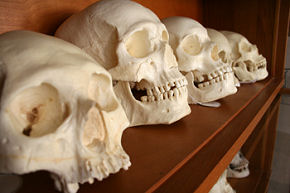
A study of 16th century European skulls by North Carolina State University researchers has found that women are beginning to resemble men as differences in gender-associated craniofacial features become less over time. The study, appearing in the journalForensic Science International, examined hundreds of Spanish and Portuguese skulls spanning four centuries.
Principal researcher, Dr. Ann Ross, said that craniofacial differences between contemporary men and women are less pronounced than they were in the 16th century. While craniofacial features for both sexes in Spain have changed over time, she explained, the changes have been particularly significant in females. “For example, the facial structure of modern Spanish females is much larger than the structure of 16th century females. This difference may stem from improved nutrition or other environmental factors,” she suggested.
Ross said the researchers paid particular attention to structural differences between male and female skulls because; “this can help us establish the sex of the remains based on their craniofacial features, which is particularly important when an incomplete skeleton is found. Being able to tell if a skull belonged to a man or woman is useful in both criminal investigation and academic research.”
Related:
Men fueling plastic surgery boom
Modern Man In Evolutionary Fast Lane
Country boys boast bigger junk
The “perfect” body not always perfect


















Comments are closed.